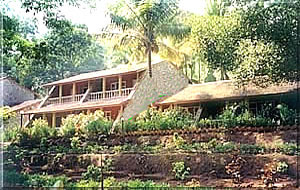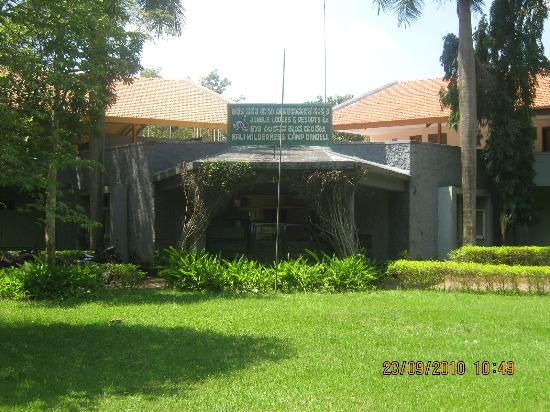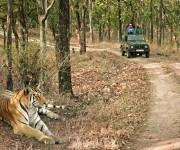Location: Umaria, Madhya Pradesh India.
Area: 1161 sq. km (Combining Core and buffer forest)
Vegetation: Tropical moist deciduous, dry deciduous and scrub
Established: 1968
Major Wildlife Attractions: Bengal Tiger, Leopard, Sloth Bear, Chital, Sambar deer, Jackal, Indian Fox, Wild Boar
Recommended Season: November to June
Bandhavgarh national park have a very long history. Set among the Vindhya hills of Madhya Pradesh with an area of 168 sq. miles (437 sq. km), it contains a wide variety of habitats and a high density of game, including a large number of tigers. Bandhavgarh was declared Project Tiger Reserve in 1993.
Geography, Flora and Climate: When originally formed in 1968, Bandhavgarh was a comparatively small park of only 40 sq. miles (105 sq. km), but in mid-1986 it was extended to include two large areas of forest adjoining it on the northern and southern sides. These extension areas consist mainly of Sal forest. In the north a series of ridges, inter cut by perennial streams, runs parallel to the main Umaria road which runs through the park. To the south, gently undulating forest is interspersed with grazing areas, formerly agricultural land.
Currently the central area of the park the original 40 sq. miles - remains the principal viewing area. There are 32 hills in this part of the park, which has a large natural fort at its canter. The fort's cliffs are 2625 feet (800 meters) high, 1000 feet (300 meters) above the surrounding countryside. Over half the area is covered by Sal forest although on the upper slopes it is replaced by mixed forest of Sali, Saj, Dhobin and Saja. Towards the north there are large stretches of bamboo and grassland. Most of the bamboo flowered in 1985 and the old clumps died, leaving the ground covered with new bamboo growth. Many streams run through the valleys but only three are perennial. One of them, the Charanganga, has its source at the fort.
History: Bandhavgarh has been a canter of human activity and settlement for over 2000 years. Legend has it that Rama, hero of the Hindu epic, the Ramayana, stopped at Bandhavgarh on his way back to his homeland after defeating the demon king Ravana of Lanka. Two monkey architects, who had engineered a bridge between the isle of Lanka and the mainland, are said to have built Bandhavgarh's fort. Later Rama handed it over to his brother Lakshmana who became known as bandhavdhish, "the lord of the fort" - a title still used by the present "lord of the fort," the former Maharaja of Rewa. Lakshmana is the particular god of the fort and is regularly worshiped in a temple there.
The oldest signs of habitation in the park are the caves dug into the sandstone to the north of the fort. Several contain Brahmi inscriptions dating from the 1st century B.C. From that time onwards Bandhavgarh was ruled by a succession of dynasties including the Chandela kings of Bundelkhand who built the famous temples at Khajuraho. The Baghel kings, the direct ancestors of the present royal family of Rewa, established their dynasty at Bandhavgarh in the 12th Century. It remained their capital till 1617 when the canter of court life moved to Rewa, 75 miles (120 km) to the north. Without royal patronage Bandhavgarh became more and more deserted until forest overran the area and it became a royal hunting reserve. This helped to preserve the forest and its wildlife, although the maharajas made full use of their rights. Each set out to kill the auspicious number of 109 tigers.
At independence Bandhavgarh remained the private property of the maharaja until he gave it to the state for the formation of a national park in 1968. After the park was created poaching was brought under control and the number of animals rose dramatically. Small dams and water holes were built to solve the problem of water shortage. Grazing by local cattle was stopped and a village within the park boundaries was relocated. The tigers in particular prospered and the 1986 extension provided much needed forest to accommodate them.
Within the Park: Bandhavgarh is justifiably famous for its tigers, but it has a wide range of other game. The undergrowth is not as dense as in some northern Terai forests, but the best time to see the park's inhabitants is still the summer months when water becomes scarcer and the undergrowth dies back.
Chinkara, still rather shy, can be sighted on the grassland areas of the park, particularly on formerly cultivated land in the southern extension area, on the edges of the main viewing area. Also to be seen in the grasslands are Nilgai, Chausingha and sounders of wild boar, as well as the occasional jackal or fox. In March and April gaur, or Indian bison, move down from the higher hills to the southeast of the park and make their way through the southern extension area to the central meadows of the park to graze. The need for water and good grazing draws them to the park and they return to the south-eastern hills at the onset of the monsoon.
Muntjac and Sambar prefer denser vegetation. The main prey animal, however, for the tigers and the park's rarely sighted leopards are the chital, which now number a few thousand.
There are two types of monkey common in the park - the rhesus macaque and the black-faced langur. Drives can also reveal jungle cats, hyenas, porcupines, rattles and a variety of other mammals. At least one small pack of wild dogs inhabits the central area of the park.
As the park is relatively new, there is still a good chance of adding birds to the checklist of some 150 species already compiled. Bandhavgarh attracts many migratory birds in the winter months, including birds of prey like the steppe eagle and a variety of wildfowl. However, as it has limited water surfaces it cannot compete with parks with large areas of wetland. While you aren't allowed to go into the park on foot, the park headquarters and the Jungle Camp offer excellent opportunities to watch the smaller birds. Attracted by flowering and fruiting trees, some very attractive and less common birds can be seen - for example the blue-bearded Bee eater, the white-bellied drongo, Tickell's blue flycatcher, the white-browed fantail, both the gold-fronted and Jerdon's leaf birds, mini vets and wood shrikes. Any large fruiting tree generally reveals a population of green pigeons and some of the noisiest residents - blossom-headed parakeets. Gray and, less often, the magnificent black and white Malabar hornbills, fly across. On roads through the Sal forests it's worth looking out for the large racket-tailed drongo and the dipping plumes of the paradise flycatcher.
The Fort The fort still belongs to the Maharaja of Rewa and permission is required to visit it. However permission is available locally and no trip to Bandhavgarh can really be complete without making the effort to climb up to the fort.
There are two ways up on to the plateau, a jeep track and a footpath - both steep. It is far easier to see the fort by jeep but much more rewarding to make the journey on foot. There is a convenient place to park vehicles on the southern side of the fort in the lush jungle which surrounds its base. This point is known as Shesh Saya, named after a unique 35-foot (II-meter) long statue of a reclining Vishnu carved around the 10th Century, from whose feet the Charanganga is said to flow. A rectangular pool of spring water lies just beneath the statue and the path to the main gate of the fort, the Karn Pol, leads off to the left of the pool. On the other side of this imposing gateway lie 560 acres (227 hectares) of grassland, over which are scattered turtle-filled tanks and the many remains of the human inhabitants of the fort from ancient statues to the barracks occupied by Rewa's troops up to independence. At a brisk pace the walk from the Shesh Saya to the southern side of the fort need only take an hour, but if you stop to see the statues and temples on the way it can easily take much longer. As you follow the path southwards, the most remarkable sights are the 10th-Century rock images of the incarnations of Vishnu. A statue of Narasimha (half-man half-lion) towers almost 22 feet (seven meters) above the grass. There is a carving of Sarah Bhagwan (the boar incarnation), and a small temple enshrining a large image of Vishnu in his fish avatar. The tortoise incarnation stands unenclosed and flanked by later carvings of Ganesh, the elephant god, and other deities. The charm of this walk lies in discovering these monuments in the jungle, unspoilt and unexploited. Some of the statues lie off the main path and so it is best to take a guide. Apart from the avatars, well worth seeing are three small temples of around the 12th Century. These temples are deserted but the fort is still used as a place of worship. Kabir Das, the celebrated 16th-Century saint, once lived and preached here.
The natural ramparts of the fort give breath-taking views of the surrounding countryside. Vultures wheel around the precipice which also attracts blue rock thrushes and crag martins. The fort has a small population of blackbuck, which have been reintroduced and to some extent protected from tigers in the park below by repairs to the masonry walls at the edges of the fort.
Thus Bandhavgarh offers excellent game and bird viewing and a historical interest which most other parks lack. It is a comfortable drive from Khajuraho and so visitors can enjoy both the temples of the one and the wildlife of the other in one trip. And for those who enjoy train travel Bandhavgarh has two railway stations within reach Umaria and Satna
By Air: Nearest Airport: Jabalpur Airport, 200 km away, By Rail: Nearest Railway Station: Umaria Railway Station, 35 Km away, By Road: Take Taxi or Bus from Jabalpur or Umaria to Bandhavarg.




